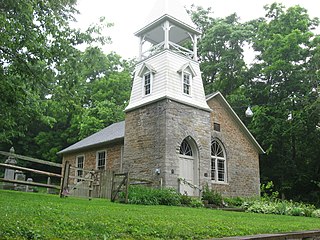This page is based on this
Wikipedia article Text is available under the
CC BY-SA 4.0 license; additional terms may apply.
Images, videos and audio are available under their respective licenses.

The Evangelical United Brethren Church (EUB) was an American Protestant church formed in 1946, by the merger of the Evangelical Church and the Church of the United Brethren in Christ. The United Brethren and the Evangelical Association had considered merging off and on since the early 19th century because of their common emphasis on holiness and evangelism and their common German heritage.

The National Register of Historic Places in the United States is a register including buildings, sites, structures, districts, and objects. The Register automatically includes all National Historic Landmarks as well as all historic areas administered by the U.S. National Park Service. Since its introduction in 1966, more than 90,000 separate listings have been added to the register.
A Carnegie Library is a library built with money donated by Scottish-American businessman and philanthropist Andrew Carnegie.
"Christ Episcopal Church" may refer to the following similarly named churches or parishes in the United States:
America's Most Endangered Places or America's Most Endangered Historic Places is a list of places in the United States that the National Trust for Historic Preservation considers the most endangered. It aims to inspire Americans to preserve examples of architectural and cultural heritage that could be "relegated to the dustbins of history" without intervention.
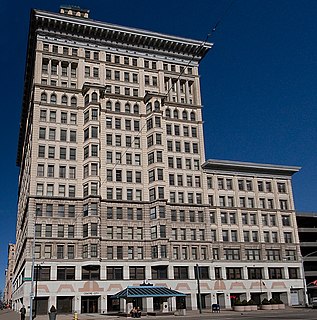
The Centre City Building is an historic building at 36-44 South Main Street at the corner of East Fourth Street in downtown Dayton, Ohio. It was designed by Charles Herby and built in 1904 by the F.A. Requarth Co. for the sum of $305,000 as the headquarters of the Church of the United Brethren in Christ Christian denomination. Originally 14 stories, it was the tallest building in Dayton from 1904 until 1931. Its tower portion was completed in 1927, making it 21 stories and one of the tallest reinforced concrete buildings in the world at that time.
Madison Historic District may refer to:
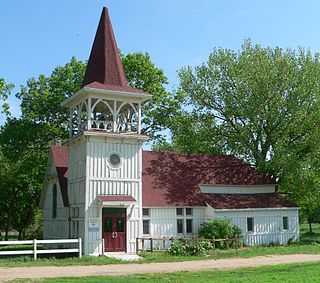
The Church of Our Most Merciful Saviour, also known as the Santee Mission, built in 1884, is a historic Carpenter Gothic style Episcopal church located on the Missouri River in the Santee Indian Reservation in Santee, Nebraska. Although its side windows are not arched, it otherwise exhibits all the common features of Carpenter Gothic churches: board and batten siding, lancet windows on the front along with a circular rosette window, belfry tower on the side and main entrance on the side though the belfry tower.
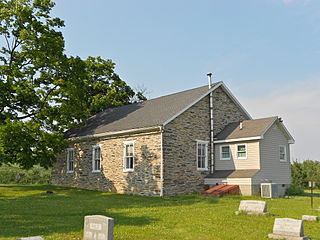
Cline's Church of the United Brethren in Christ, also known as Cline's United Methodist Church, is a historic Brethren church on Cline's Church Road, 0.5 miles south of PA 34 at Menallen Township, Adams County, Pennsylvania. It was built in 1850, and is a one-story, plain rectangular limestone building with a low gable roof. It measures 35 feet wide and 46 feet deep. The interior is a single room with white plastered walls and ceiling. Located adjacent to the church is the Cline's Cemetery, with grave markers dated from the mid-1800s to the present.
Saints Peter and Paul Catholic Church or Saints Peter and Paul Catholic Church Complex may refer to:
United Church of Christ, Congregational may refer to:
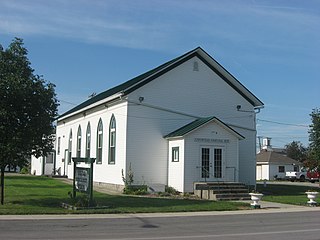
The Uniopolis Town Hall is a historic village hall and museum in Uniopolis, Ohio, United States. Built in 1875, this Gothic Revival structure was built as a church, the Divinity Church of the United Brethren in Christ. The building ceased to be used for this purpose in 1900, when it was purchased by the village of Uniopolis and converted into a village hall. After more than ninety years of service as a village hall, the building began a process of conversion into the museum of the Uniopolis Historical Society.
St. John's German Evangelical Church or variations may refer to:

The Evangelical United Brethren Church is a former church and a historic building at 409 N. Maple in Watertown, South Dakota. It was built in 1914, affiliated with the Church of the United Brethren in Christ until around 1946, when a merger formed the Evangelical United Brethren Church. For a time it was used by Seventh-day Adventists. It is now a private residence.
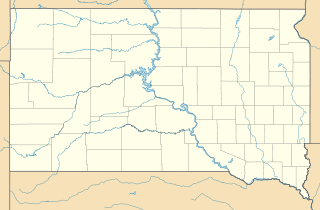
United Brethren Church in Christ is a historic church on Lots 5 through 10 in Block 20 in Milltown, South Dakota. It has also been known as Milltown United Brethren in Christ Church. It was built in 1880 and was added to the National Register in 2007.

United Brethren Church, also known as Pleasant Hill Chapel is a church in Union County, South Dakota. It was built in 1905 and was added to the National Register of Historic Places in 2001.
